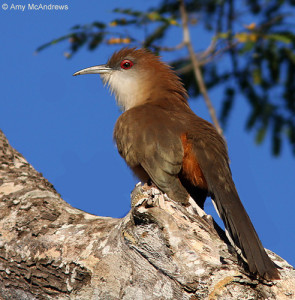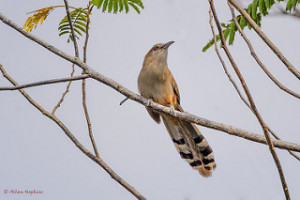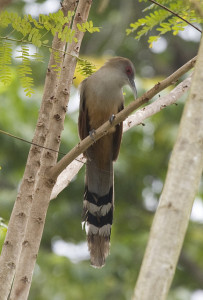Content for this page researched and created by Andrew Soxman

Cuckoos can be found all around the world usually in either tropical or temperate regions. Based on the biogeography of cuckoos they originated in southern regions of the world (Payne and Sorenson). Their habitats usually consist of forests and woodlands which contain an immense amount of vegetation. They are attracted to warmer tropics but they also prosper in cool and wet conditions in either forests or open habitats (Payne and Sorenson). Cuckoos are zygodactyl, which is a unique characteristic of having two toes pointing forward and two pointing backwards (Payne and Sorenson). Most cuckoos have long tails compared to most birds (Bond). Cuckoos for the most part are Brood parasitic but there are some that are nonparasitic. The brood parasitic cuckoos lay their eggs in another birds nest and that bird acts as a host for the cuckoo’s young (Kruger).
The Great Lizard-Cuckoo (Coccyzus merlini) belonged to the old genus Saurothera which is translated as lizard-hunter (Neotropical Birds Online). Many Scientists analyzed their DNA and made the assumption that they descended from two other cuckoos (Banks). They are members of the avian Cuculidae family (Wildlife Rehabber). Their genus was recently renamed Coccyzus (Naturewatch). The Great Lizard-Cuckoo has an array of nicknames which include Big Rain Crow, Kataw, and the Cuban Lizard Cuckoo (Bond).

Great Lizard-Cuckoos has many physical characteristics which makes them an extremely unique bird species. They are about 44-55cm (17-22in) in length which is a result of their tremendously elongated tail (Raffaele). On average the Great Lizard-Cuckoo weighs around 155 grams (Taylor). The Great Lizard-Cuckoo is the largest of all the cuckoos (Bird Genus). Although specific parts of their bodies are different colors they are mostly an olive brown color (Bond). Their long tails have very narrow feathers with white tips (Payne and Sorenson). They also have long bills that have a minor downward curve near their ends(Wildlife of the Caribbean). Their breasts are a light grey and they have a red tinted belly (BirdForum). Interestingly, they don’t grow feathers around their eyes so they have a bare skin ring around their eyes which is red in color (Bond). The two adult sexes look very similar and are difficult on casual examination to tell apart (Payne). Their feet are grey in color and are unique because they have two toes pointing forward and backwards (Payne) (Payne and Sorenson). Their physical features are very distinct and separate them from other cuckoos.
Cuckoos are found all around the world but Great Lizard-Cuckoos are typically found in Cuba and the Bahamas (Kirwan) (Payne and Sorenson). In the Bahamas they are relegated to specific areas such as Andros, Eleuthera, and New Providence (Raffaele). They have a very small population in the Bahamas and are of conservation concern there, but overall their population is stable and without substantial threats (Mitchell) (Currie Habitat). They are most commonly found in Cuba where they are a resident species and have a range of 110,000km ^2 (Mitchell) (BirdForum). Along with other species the Great Lizard-Cuckoos were able to thrive in Cuba (Garrido). Usually they can be found living in densely wooded and bushy areas (Raffaele) (BirdForum). “They inhabit tropical and subtropical dry broadleaf forests, lowland and montane, moist broadleaf forests, as well as heavily degraded former forest” (Bird Genus). Many were found in habitats that included pines and shrubs (Currie Habitat). In these forests they can be found more specifically in sawgrass and marshes (Kirwan). They were also found in human-modified habitats like abandoned coffee plantations and overgrown pastures (Mann).

As mentioned earlier there are two types of Cuckoos: nonparasitic and brood parasitic. Parasitic cuckoos are birds that give up their young to another bird called a host bird (Kruger). The host bird can be any of a variety of species which will raise the young of another bird and treat them as their own (Kruger). Parasitic birds tend to have a small egg size so there is more opportunities of finding a host to raise their young (Kruger). Unlike these parasitic cuckoos, however, the Great Lizard-Cuckoos raise their own youth (Taylor). Just like the majority of other birds, they lay their eggs (which are larger than hose of the parasitic cuckoo species) in a nest made up of twigs and grass (BirdForum). They can lay four clutches of eggs in a year. Each clutch may have two to three eggs (Roman) (Taylor). The Great Lizard Cuckoo’s eggs have been intensely studied in order to quantify the past and present breeding distribution of the species (Roman).
The Great Lizard-Cuckoos molt their feathers between July to November (Pyle). The first prebasic molt, which is the first level where the birds replace all their feathers, appears to be incomplete in many individuals (Pyle). During molting the Great Lizard-Cuckoos does not shed any of their flight feathers (Pyle). The molt limits and the shape of its primary coverts are very important factors in determining the age of an individual Cuban land bird (Pyle).
They have a very long and loud voice that has a distinct sound often sounding as ka-ka-ka-ka….. (Wildlife of the Caribbean).

Great Lizard-Cuckoos are poor fliers that often just glide from treetop to treetop (Bird Genus). They are categorized as Cuban land birds because they frequently spend a lot of time on the ground looking for prey to feed on (Pyle) (Bird Genus). They use probing and gleaning tactics to explore through rotting logs that are on the ground (Cruz). They are moderately quick and can be found running after or chasing their prey (Powell).
Cuckoos are opportunists that feed on a variety of many different arthropods (Powell). The Great Lizard specifically feeds on lizards, snakes, locusts, frogs, and large insects (Garrido) (BirdForum). These birds also feed on surprisingly small insects (Neotropical Birds online). Large quantities of beetles have been found in the stomachs of Great Lizard-Cuckoos (Cruz). They often focus on seasonally abundant prey, such as caterpillars (Powell). They have a variety of prey, but lizards are their main source of food, giving them the name Great Lizard-Cuckoo (Garrido).
General References
Bird Genus Coccyzus. Beauty of Birds. Avianweb, 2011. Web. 30 Sept. 2015.
Bond, James. Birds of the West Indies. Boston: Houghton-Mifflin, 1971. Print.
Garrido, Orlando H., and Arturo Kirkconnell. Field Guide to the Birds of Cuba. Ithaca, NY: Comstock Pub., 2000. Print.
Great Lizard Cuckoo. BirdForum. 2013. Web. 30 Sept. 2015.
Great Lizard-Cuckoo (Coccyzus Merlini). NatureWatch NZ. INaturalist Netwrok, n.d. Web. 30 Sept. 2015.
Great Lizard-Cuckoo (Coccyzus Merlini) Neotropical Birds Online. 2010. Web. 30 Sept. 2015.
Great Lizard-Cuckoo. Wildlife Rehabber. Wildlife Rehabber, 2015. Web. 30 Sept. 2015.
Kirwan, G., A. Kirkconnell, and G. M. Flieg. A Birdwatchers’ Guide to Cuba, Jamaica, Hispaniola, Puerto Rico and the Caymans. Cley next the Sea, Norfolk: Prion, 2010. Print.
Mitchell, A. Cuban Lizard-cuckoo Coccyzus Merlini. BirdLife International, 2015. Web. 30 Sept. 2015.
Payne, Robert B., and Michael D. Sorenson. The Cuckoos. Oxford: Oxford UP, 2005. Print.
Raffaele, Herbert A., and James Wiley. Wildlife of the Caribbean. Print.
Raffaele, Herbert A. Birds of the West Indies. Princeton: Princeton UP, 2003. Print.
Taylor, Chistopher. Nature and Wildlife Photography. Great Lizard Cuckoo. Cristopher Tayor, 2015. Web. 30 Sept. 2015.
Scientific References
Banks, Richard C., et al. “Forty-Seventh Supplement to the American Ornithologists’ Union Check-List of North American Birds.” The Auk 123.3 (2006): 926-36. Lion Search. Web. 30 September 2015.
Cruz, Alexander. “Ecology and behavior of the Jamaican Lizard Cuckoo.” Studies on the Fauna of Curaçao and other Caribbean Islands 46.1 (1975): 109-111. Google Scholar. Web. 30 September 2015.
Currie, Dave, et al. “Habitat distribution of birds wintering in central Andros, The Bahamas: implications for management.” Caribbean journal of science 41.1 (2005): 75-87. Google Scholar. Web. 30 September 2015.
Currie, D. A. V. E., et al. “Winter avian distribution and relative abundance in six terrestrial habitats on southern Eleuthera, The Bahamas.” Caribbean Journal of Science 41.1 (2005): 88-100. Google Scholar. Web. 30 September 2015.
Garrido, Orlando H. “Natural and man-induced evolutionary shifts in the birds of some Cuban cays.” Bird Conservation International 2.01 (1992): 1-6. Google Scholar. Web. 30 September 2015.
Kruger, O., and NB Davies. “The Evolution of Egg Size in the Brood Parasitic Cuckoos.” Behavioral Ecology 15.2 (2004): 210-8. Lion Search. Web. 30 September 2015.
Levy, C. “Notes On The Nesting Of The Jamaican Lizard Cuckoo.” Gosse Bird Club Broadsheet 42 (1984): 6-8. Wildlife & Ecology Studies Worldwide. Ebsco Host. Web. 30 September 2015.
Mann, Clive F., Frederik Brammer, and Richard A. Fuller. Cuckoos of the World. A&C Black, 2012. Google Scholar. Web. 30 September 2015.
Pyle, Peter, et al. “Molt patterns and age and sex determination of selected southeastern Cuban landbirds.” Journal of Field Ornithology 75.2 (2004): 136-145. Google Scholar. Web. 30 September 2015.
Román, Rafaela Aguilera, and James W. Wiley. “Bird egg and nest specimens in the collection of the Instituto De Ecología Y Sistemática, La Habana, Cuba.” Journal of Caribbean Ornithology 25.1 (2013): 15-23. Google Scholar. Web. 30 September 2015.
Image References
Flickr. Yahoo!, 27 January, 2010 – 13 April, 2015. Web. 30 Sept. 2015. https://www.flickr.com/photos
- Great Lizard Cuckoo on a branch with blue sky in background (A. McAndrews)
- Great Lizard Cuckoo on a skinny branch looking down (L. Gooch)
- Great Lizard Cuckoo on green leaves (F. Veronesi)
- Great Lizard Cuckoo on tree limb (A. Hopkins)
(Some rights reserved) Free to share and adapt as long as you give appropriate credit.